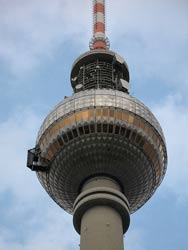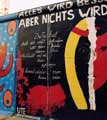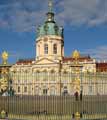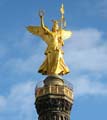Berlin is the capital of the German Republic. This  city is located on the site where the river Spree flows into the river Havel. The city's area of 890 square kilometers. The population for 1995 is 3.5 million. It is worth noting that before the Second World War, it was 4.3 million.
city is located on the site where the river Spree flows into the river Havel. The city's area of 890 square kilometers. The population for 1995 is 3.5 million. It is worth noting that before the Second World War, it was 4.3 million.
Berlin is mentioned in the annals of the city with the first half of the 13th century. In its history the city was the capital of two states: first Prussia and then Germany. Berlin - one of the major cultural, industrial and scientific centers.
After the Second World War, Berlin was completely captured by the troops of the opposing forces, and was later divided into several zones of occupation.
Since the mid-20th century saw the restoration of the city, and by that time it was built up with new buildings and structures. In 1961, under the decision of the Warsaw Treaty in Germany was built wall separating West Berlin and the German Democratic Republic. After 1990 the wall was destroyed, the status of the German capital of Bonn moved to Berlin.
After the war, the city began to grow. From scratch, new streets, squares and neighborhoods. Rebuilt the old buildings, and non-residential areas, while the former so-called zones of death, populated by people.
Berlin is now one of the most developed cities not only in Germany but across Europe. Around the world renowned University of Berlin, a museum and cultural organizations. In Berlin, there are well-known theaters "Komische Opera" and the "Berliner Ensemble". Berlin is great value as an example of Gothic, baroque and classical styles of construction
10 things you need to do in Berlin
- Go on tour.
- Take a walk down the street Unter den Linden, the famous boulevard, coming from the Brandenburg Gate to the Alexanderplatz square.
- Visit the Museum Island, where there are five important museums of the city and the Berlin Cathedral.
- Visit to the famous square Alexanderplatz TV tower.
- Walk around the block Nikolaiviertel, located around the oldest church in Berlin - St. Nicholas Church, planted in 1200.
- Drink the famous Berlin Berliner Weisse beer, enjoy traditional German cuisine.
- Gendarmenmarkt.
- To make shopping.
- Visit the Potsdamer Platz square and located her culture forum.
- Arriving in Berlin, we can not go to the club.
Sights of Berlin
In the capital there are more than 170 museums and collections, more than 150 theaters, eight symphony orchestras, three opera houses, 880 choirs, 180 cinemas, 500 palaces and parks.
Brandenburg Gate were built from 1788 to 1791 by the architect Carl Gotthard Langhans-type Propileev Athenian Acropolis as a representative end street Unter den Linden.
Academy of Arts
DZ Bank AG. On the south side of the square Pariser Platz is a building of the German Central Cooperative Bank, designed by architect Frank O. Gehry.
Triumphal Column has been created from 1865 to 1873 on the project in honor of Henry Shtraka victories in the wars of 1864, 1866 and 1870/71 years and is set on the square in front of the Reichstag.
Reichstag , built from 1884 to 1894, witnessed all the important moments of the twentieth century German history since the Republic was proclaimed in 1918 and set fire to the Reichstag in 1933 and ending with the reunification of Germany in 1990.
Old Museum Karl Friedrich Schinkel, the most important architectural masterpiece in Europe in the classical style, was built from 1824 to 1829 in order to provide for public view the royal art collection.
Museum Island , located between the two arms of the Spree, Berlin, making the museum one of the most important cities in the world. It includes the Bode Museum, Pergamon Museum, Old National Gallery, the Old Museum and the New Museum. Pergamon Museum was specially built for the unique architectural and historical monuments (Pergamon altar, Babylonian goddess Ishtar Gate, Market Gate of Miletus and other cities).
Between the channel and the New Museum Kupfergraben build a new building James-Simon-Galerie, where there will be an information center for visitors.
German Historical Museum. The former Arsenal, built in 1706, was the first major building in the Baroque style in Berlin. Originally the building was used as a warehouse for the storage of trophies and weapons.
German State Opera . Built by architect Knobelsdorffom 1741 to 1743 opera, completely burned down in 1843, was restored by architect Langhans. Approximately up to 2013/2014, the building is under construction.
Humboldt University was founded at the initiative of Wilhelm von Humboldt in 1810.
Berlin Cathedral (1893 - 1905) In the seventies, the facade damaged during the Second World War, the cathedral was restored, restoration of the inside of the building was completed in 1993.
Church of St. Nicholas. In 2010, celebrated 800 years the oldest church in Berlin.
Berlin Town Hall. Since 1991, the Berlin Town Hall is the residence of the reigning mayor united capital. It was built from 1861 to 1869 on a draft of Hermann Friedrich Vezemanna.
Church of the Virgin Mary, the second oldest parish church in Berlin, was founded in the second half of the XIII century.
Gendarmenmarkt is one of the most beautiful squares in Berlin.
Charlottenburg Palace From 1695 to 1699 on the orders of the Elector of Brandenburg and Prussia in 1701 King Frederick III had a palace Littsenburg (initial name).
Soviet monument, memorial on the street on June 17 near the Brandenburg Gate keeps the memory of some 20 thousand Soviet soldiers who died in the battle for Berlin during the Second World War.
From the history of Berlin
Berlin became the capital of Prussia in 1701, and 1709-m merged into one of five cities:
parts of Berlin were Cologne, Friedrichswerder, Doroteenshtadt and Friedrichstadt that previously were considered suburbs. During the reign of Frederick the Great's good reputation of the city on the right bank of the River Spree (Spree), spread throughout Europe.
In 1760, during the Seven Years' War, Berlin capitulated to the Russian corps commanded by General Chernyshov. He received a mountain of weapons as trophies, two million thalers contributions and the symbolic keys to the city, which until now kept in the Kazan Cathedral in St. Petersburg. However, after four days of Earl brought his body to learn about the approach to the city of large parts of the enemy. Secondary Russian troops entered Berlin in 1813, pursuing the remnants of Napoleon's army, which occupied the city in 1806.
By 1861 Berlin had grown a new suburbs, and in 1871, after the establishment of the Second Reich was proclaimed the capital of the empire. However, the Prussian luxury was always hand in hand with greed, which eventually led to the defeat of Imperial Germany in World War II. By its end in the country was proclaimed the Weimar Republic. In 1920 a law was passed on the formation of Greater Berlin, which marked the territory of the city is practically in its present borders. By that time its population reached 4 million people.
Public transport
Tickets for public transport in Berlin are the same and are valid for buses, trams, underground (U-Bahn) trains and surface (S-Bahn) and ferries. All transport runs on a schedule to the minute, from about 4.30 am to 12.30 am daily. On weekends and holidays the central subway lines work around the clock.
At night in the city can move on night buses and trams.
The city is divided into three zones: A - central, B - middle, and C - Outskirts.
Tickets vary by zones (AB, BC, ABC) and the time of the ticket.





